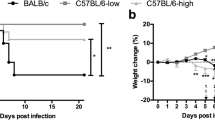Summary.
In C.B-17 severe combined immunodeficiency (SCID) mice, corneal challenge with herpes simplex virus-1 (HSV-1) KOS strain usually leads to fatal encephalitis. With the transfer of T cells from immunized BALB/c mice, these SCID mice developed a latent HSV-1 infection. In order to determine the responsible T cell subset, fractionated immune T cells were transferred. Those SCID mice transferred with immune CD4+T cell-enriched fraction developed latent HSV-1 infection in their trigeminal ganglia. Their splenocytes had an increased percentage of CD4+T cells and showed a proliferative response against HSV-1. The transfer of CD8+T cells increased survival in the acute infection, but their engraftment seemed less needed for latency than that of CD4+T cells. Mice that received immune serum survived without developing latent HSV-1 infection. Some latently infected SCID mice had anti-HSV antibodies while others did not, indicating that the engraftment of antibody-producing B cells was not required for latency. Thus, immune CD4+T cells were important for the survival of SCID mice with latent HSV-1 infection. This animal model should be useful for investigation of latency/reactivation of HSV-1.
Similar content being viewed by others
Author information
Authors and Affiliations
Additional information
Received February 27, 2000/Accepted June 2, 2000
Rights and permissions
About this article
Cite this article
Minagawa, H., Yanagi, Y. Latent herpes simplex virus-1 infection in SCID mice transferred with immune CD4+T cells: a new model for latency. Arch. Virol. 145, 2259–2272 (2000). https://doi.org/10.1007/s007050070019
Published:
Issue Date:
DOI: https://doi.org/10.1007/s007050070019




